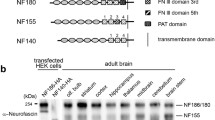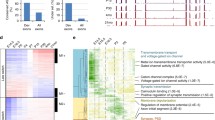Abstract
Ever since its description and the generation of its defining antibody, some 20 years ago, neural nuclei (NeuN) have been an invaluable tool for developmental neuroscientists and neuropathologists to identify neurons and follow their normal or malignant development. The recent identification of the splicing factor Rbfox3 as the molecule constituting the genuine NeuN epitope has opened up a novel perspective on NeuN immunostaining and its interpretation. Here, we briefly review these recent developments, and we provide a series of data that allow to rationalize the specificity of the NeuN/A60 antibody on aldehyde-fixed tissues on the one hand, and its cross-reactivity with Synapsin I and R3hdm2 on Western blots on the other. We argue that rather than being considered as a mere marker for mature neurons, Rbfox3-mediated NeuN/A60 immunoreactivity may provide a window onto neuronal biology. Specifically, we hypothesize that the phosphorylation-dependent antigenicity of the Rbfox3/NeuN epitope should allow to visualize neuronal physiology realized through Rbfox3, including splicing, on the single-cell level.







Similar content being viewed by others
References
Abello N, Kerstjens HAM, Postma DS, Bischoff R (2007) Selective acylation of primary amines in peptides and proteins. J Proteome Res 6:4770–4776
Barbosa-Morais NL, Irimia M, Pan Q, Xiong HY, Gueroussov S, Lee LJ, Slobodeniuc V, Kutter C, Watt S, Colak R, Kim T, Misquitta-Ali CM, Wilson MD, Kim PM, Odom DT, Frey BJ, Blencowe BJ (2012) The evolutionary landscape of alternative splicing in vertebrate species. Science 338:1587–1593
Blom N, Gammeltoft S, Brunak S (1999) Sequence and structure-based prediction of eukaryotic protein phosphorylation sites. J Mol Biol 294:1351–1362
Cannon JR, Greenamyre JT (2009) NeuN is not a reliable marker of dopamine neurons in rat substantia nigra. Neurosci Lett 464:14–17
Canova-Davis E, Eng M, Mukku V, Reifsnyder DH, Olson CV, Ling VT (1992) Chemical heterogeneity as a result of hydroxylamine cleavage of a fusion protein of human insulin-like growth factor I. Biochem J 285:207–213
Chin LS, Li L, Ferreira A, Kosik KS, Greengard P (1995) Impairment of axonal development and of synaptogenesis in hippocampal neurons of Synapsin I-deficient mice. Proc Natl Acad Sci USA 92:9230–9234
Damianov A, Black DL (2010) Autoregulation of Fox protein expression to produce dominant negative splicing factors. RNA 16:405–416
Dredge BK, Jensen KB (2011) NeuN/Rbfox3 nuclear and cytoplasmic isoforms differentially regulate alternative splicing and nonsense-mediated decay of Rbfox2. PLoS ONE 6:e21585
Dubuc AM, Morrissy AS, Kloosterhof NK, Northcott PA, Yu EP, Shih D, Peacock J, Grajkowska W, van Meter T, Eberhart CG, Pfister S, Marra MA, Weiss WA, Scherer SW, Rutka JT, French PJ, Taylor MD (2012) Subgroup-specific alternative splicing in medulloblastoma. Acta Neuropathol 123:485–499
Feng J, Chi P, Blanpied TA, Xu Y, Magarinos AM, Ferreira A, Takahashi RH, Kao HT, McEwen BS, Ryan TA, Augustine GJ, Greengard P (2002) Regulation of neurotransmitter release by Synapsin III. J Neurosci 22:4372–4380
Ferreira A, Chin LS, Li L, Lanier LM, Kosik KS, Greengard P (1998) Distinct roles of Synapsin I and Synapsin II during neuronal development. Mol Med 4:22–28
Gitler D, Takagishi Y, Feng J, Ren Y, Rodriguiz RM, Wetsel WC, Greengard P, Augustine GJ (2004) Different presynaptic roles of synapsins at excitatory and inhibitory synapses. J Neurosci 24:11368–11380
Glassmann A, Molly S, Surchev L, Nazwar TA, Holst M, Hartmann W, Baader SL, Oberdick J, Pietsch T, Schilling K (2007) Developmental expression and differentiation-related neuron-specific splicing of metastasis suppressor 1 (Mtss1) in normal and transformed cerebellar cells. BMC Dev Biol 7(111):111
Jung YJ, Park SJ, Park JS, Lee KE (2004) Glucose/oxygen deprivation induces the alteration of Synapsin I and phosphosynapsin. Brain Res 996:47–54
Kim KK, Adelstein RS, Kawamoto S (2009) Identification of neuronal nuclei (NeuN) as Fox-3, a new member of the Fox-1 gene family of splicing factors. J Biol Chem 284:31052–31061
Kim KK, Kim YC, Adelstein RS, Kawamoto S (2011) Fox-3 and PSF interact to activate neural cell-specific alternative splicing. Nucleic Acids Res 39:3064–3078
Kim KK, Nam J, Mukouyama YS, Kawamoto S (2013) Rbfox3-regulated alternative splicing of Numb promotes neuronal differentiation during development. J Cell Biol 200:443–458
Kuroyanagi H (2009) Fox-1 family of RNA-binding proteins. Cell Mol Life Sci 66:3895–3907
la Cour T, Kiemer L, Molgaard A, Gupta R, Skriver K, Brunak S (2004) Analysis and prediction of leucine-rich nuclear export signals. Protein Eng Des Sel 17:527–536
Lal D, Reinthaler EM, Altmuller J, Toliat MR, Thiele H, Nurnberg P, Lerche H, Hahn A, Moller RS, Muhle H, Sander T, Zimprich F, Neubauer BA (2013) RBFOX1 and RBFOX3 mutations in rolandic epilepsy. PLoS ONE 8:e73323
Lee BJ, Cansizoglu AE, Suel KE, Louis TH, Zhang Z, Chook YM (2006) Rules for nuclear localization sequence recognition by karyopherin beta 2. Cell 126:543–558
Lee JA, Tang ZZ, Black DL (2009) An inducible change in fox-1/A2BP1 splicing modulates the alternative splicing of downstream neuronal target exons. Genes Dev 23:2284–2293
Lin JC, Hsu M, Tarn WY (2007) Cell stress modulates the function of splicing regulatory protein RBM4 in translation control. Proc Natl Acad Sci USA 104:2235–2240
Lind D, Franken S, Kappler J, Jankowski J, Schilling K (2005) Characterization of the neuronal marker NeuN as a multiply phosphorylated antigen with discrete subcellular localization. J Neurosci Res 79:295–302
Lowery LA, Rubin J, Sive H (2007) Whitesnake/sfpq is required for cell survival and neuronal development in the zebrafish. Dev Dyn 236:1347–1357
Marsala M, Kakinohana O, Hefferan MP, Cizkova D, Kinjoh K, Marsala S (2005) Synaptogenesis and amino acid release from long term embryonic rat spinal cord neuronal culture using tissue culture inserts. J Neurosci Methods 141:21–27
McPhail LT, McBride CB, McGraw J, Steeves JD, Tetzlaff W (2004) Axotomy abolishes NeuN expression in facial but not rubrospinal neurons. Exp Neurol 185:182–190
Melloni RH Jr, Apostolides PJ, Hamos JE, DeGennaro LJ (1994) Dynamics of Synapsin I gene expression during the establishment and restoration of functional synapses in the rat hippocampus. Neuroscience 58:683–703
Metz B, Kersten GF, Hoogerhout P, Brugghe HF, Timmermans HA, de Jong A, Meiring H, ten Hove J, Hennink WE, Crommelin DJ, Jiskoot W (2004) Identification of formaldehyde-induced modifications in proteins: reactions with model peptides. J Biol Chem 279:6235–6243
Metz B, Kersten GF, Baart GJ, de Jong A, Meiring H, ten Hove J, van Steenbergen MJ, Hennink WE, Crommelin DJ, Jiskoot W (2006) Identification of formaldehyde-induced modifications in proteins: reactions with insulin. Bioconjug Chem 17:815–822
Morgan JI, Curran T (1991) Stimulus-transcription coupling in the nervous system: involvement of the inducible proto-oncogenes fos and jun. Annu Rev Neurosci 14:421–451
Mullen RJ, Buck CR, Smith AM (1992) NeuN, a neuronal specific nuclear protein in vertebrates. Development 116:201–211
Portiansky EL, Barbeito CG, Gimeno EJ, Zuccolilli GO, Goya RG (2006) Loss of NeuN immunoreactivity in rat spinal cord neurons during aging. Exp Neurol 202:519–521
Puchtler H, Meloan SN (1985) On the chemistry of formaldehyde fixation and its effects on immunohistochemical reactions. Histochemistry 82:201–204
Ramachandran LK, Narita K (1958) Reactions involving the amide and carboxyl groups of tobacco mosaic virus (TMV) protein. Biochim Biophys Acta 30:616–624
Sahdev S, Khattar SK, Saini KS (2008) Production of active eukaryotic proteins through bacterial expression systems: a review of the existing biotechnology strategies. Mol Cell Biochem 307:249–264
Schilling K, Luk D, Curran T, Morgan JI (1991) Regulation of a fos-lacZ fusion gene: a paradigm for quantitative analysis of stimulus-transcription coupling. Proc Natl Acad Sci USA 88:5665–5669
Skopp RN, Lane LC (1988) Fingerprinting of proteins cleaved in solution by cyanogen bromide. Appl Theor Electrophor 1:61
Smith BJ (2002) Chemical cleavage of proteins at asparaginyl–glycyl peptide bonds. In: Walker JM (ed) The protein protocols handbook. Humana Press, Totowa, NJ, pp 507–510
Toews J, Rogalski JC, Clark TJ, Kast J (2008) Mass spectrometric identification of formaldehyde-induced peptide modifications under in vivo protein cross-linking conditions. Anal Chim Acta 618:168–183
Unal-Cevik I, Kilinc M, Gursoy-Ozdemir Y, Gurer G, Dalkara T (2004) Loss of NeuN immunoreactivity after cerebral ischemia does not indicate neuronal cell loss: a cautionary note. Brain Res 1015:169–174
Voineagu I, Wang X, Johnston P, Lowe JK, Tian Y, Horvath S, Mill J, Cantor RM, Blencowe BJ, Geschwind DH (2011) Transcriptomic analysis of autistic brain reveals convergent molecular pathology. Nature 474:380–384
Weyer A, Schilling K (2003) Developmental and cell type-specific expression of the neuronal marker NeuN in the murine cerebellum. J Neurosci Res 73:400–409
Williamson MP (1994) The structure and function of proline-rich regions in proteins. Biochem J 297:249–260
Author information
Authors and Affiliations
Corresponding author
Rights and permissions
About this article
Cite this article
Maxeiner, S., Glassmann, A., Kao, HT. et al. The molecular basis of the specificity and cross-reactivity of the NeuN epitope of the neuron-specific splicing regulator, Rbfox3. Histochem Cell Biol 141, 43–55 (2014). https://doi.org/10.1007/s00418-013-1159-9
Accepted:
Published:
Issue Date:
DOI: https://doi.org/10.1007/s00418-013-1159-9




